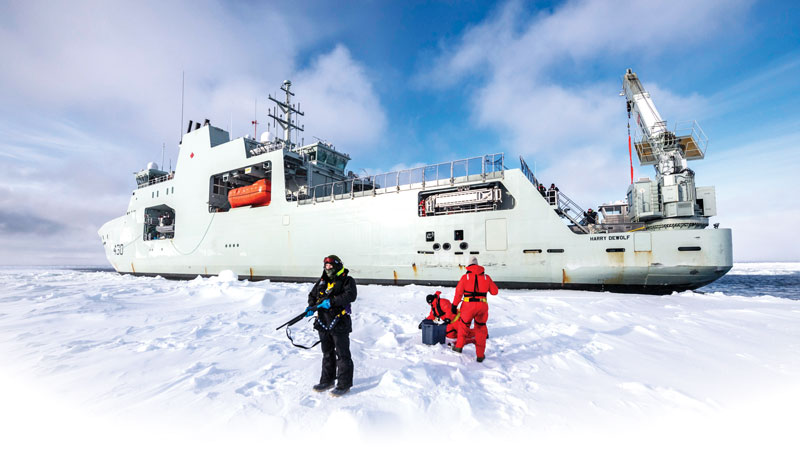
The Royal Canadian Navy returned to Arctic waters for the first time in decades in 2021, and the voyage by the newly commissioned icebreaker HMCS Harry DeWolf couldn’t have come at a better time.
The lead ship in its emerging class of Arctic offshore patrol vessels, DeWolf circumnavigated North America, sailing the Northwest Passage on the first leg of a journey that took it down the West Coast, through the Panama Canal, across the Caribbean and up the East Coast to its home port of Halifax.
DeWolf was the first RCN ship to sail the legendary route in 60 years, and it signalled a new era in Canadian sovereignty over the High Arctic (also see “Front Lines,” page 14). The region is under increasing scrutiny as the warming effects of climate change open previously inaccessible waters and Russia flexes its muscles along the edge of the Arctic Ocean.
“Canada has long paid lip service to the importance of Canadian Arctic sovereignty, but the defence of the Arctic has long been a low priority for Canadian military expenditures,” Charles Burton of Ottawa’s Macdonald-Laurier Institute told Voice of America in January.
“Now with increasing strategic interest in the region by China and opening up of year-round shipping lanes due to global warming, Canada is waking up to the need to ally with the United States and other like-minded nations and commit resources to uphold its claim to its northern territory.”
DeWolf is the first of six ice-breaking warships to be built for the navy under the federal government’s Arctic and Offshore Patrol Ship procurement project, part of the National Shipbuilding Strategy first announced in 2007.
The total project cost, including maintenance, is expected to exceed $5 billion during the six ships’ 25-year lifespan. The second breaker, HMCS Margaret Brooke, was launched in 2019 and conducted sea trials last year before it was delivered to the navy for final approvals. Two more ships are currently in the slips at Halifax Shipyard.
Two other Harry DeWolf-class patrol vessels are scheduled to be built for the Canadian Coast Guard, bringing the total to eight.
The Canadian Arctic spans three territories, extends to the North Pole, and encompasses 75 per cent of the country’s coastlines and 40 per cent of its land mass. Eight nations, including Canada, the U.S. and Russia, have mounted contesting Arctic sovereignty claims.
As Russian forces prepared to invade Ukraine early this year, its air force moved new MiG-31BM supersonic jets to an upgraded airbase at Novaya Zemlya, an archipelago on the Barents Sea, directly across the Arctic Ocean from the Canadian Forces station at Alert, on Ellesmere Island.
The Russian Northern Fleet’s 45th Air Defence Division, established in December 2015, maintains airfields and air defence bases across the Russian Arctic, from Temp in the New Siberian Islands in the east to the Nagurskoye base in Franz Josef Land in the west.
CNN has reported Russia is amassing unprecedented military might in the Arctic and testing its newest weapons in a recently ice-free region in a bid to secure its northern coast and open a key shipping route from Asia to Europe.
Weapons experts and security officials have expressed particular concern about one Russian “super-weapon,” the Poseidon 2M39 torpedo, a stealth torpedo powered by a nuclear reactor. It is designed to evade detection by sea-floor defence systems, delivering a
warhead of multiple megatons.
The radioactive fallout of such a weapon would render swaths of the target coastline uninhabitable for decades.
Satellite images detail what CNN described as “a stark and continuous build-up” of Russian military bases and hardware along its Arctic coastline, together with underground weapons storage facilities.
Besides the MiG-31MB jets, the region is stocked with Russian bombers and new radar systems near the Alaskan coast, where mainland Russia is less than 90 kilometres across the Bering Strait.
At 104 metres in length, the Harry DeWolf-class vessels are the largest Canadian warships launched in more than 50 years. Still, they are smaller and less capable than many U.S. icebreakers, which occasionally navigate the Northwest Passage with little regard for protocol.
The first of the new ships conducted exercises with U.S. icebreakers off Greenland after setting sail in August 2021, then worked with the Americans on drug interdiction operations in the Caribbean before returning home in mid-December.
Advertisement












